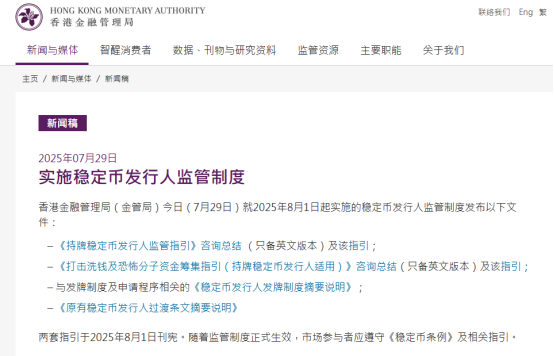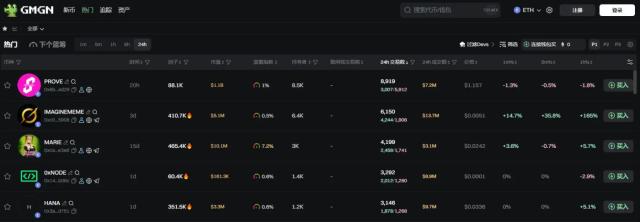On August 1st, the long-anticipated stablecoin regulation in Hong Kong officially came into effect.
Facing the market's heated speculative atmosphere, regulation once again poured cold water on stablecoins. From the content alone, Hong Kong's stablecoin regulation has many restrictions, and its stringent real-name verification requirements have earned it the title of "the world's strictest stablecoin law". Coincidentally, just a month ago, Singapore, which has always been in competition with Hong Kong, also sparked widespread discussion by issuing the "world's strictest crypto regulations".
In contrast, on the day before Hong Kong's stablecoin regulation came into effect, the U.S. Securities and Exchange Commission released a new plan called "Project Crypto", which passionately outlined the future crypto blueprint for the United States, sending a strong positive signal.
The regulatory landscape across the two sides of the ocean presents a stark contrast, and the crypto landscape is beginning to diverge at an accelerated pace.
On August 1st, Hong Kong's Stablecoin Regulation officially took effect. This milestone event is not only a significant step in Hong Kong's virtual currency domain but also marks the implementation of the world's first comprehensive regulatory framework for fiat stablecoins, with extremely far-reaching implications.
Reviewing the regulation's content, it requires any institution issuing fiat stablecoins in Hong Kong or stablecoin issuers pegged to the Hong Kong dollar from overseas to undergo mandatory licensing, with a minimum paid-in capital of 25 million Hong Kong dollars. Regarding reserve assets, it mandates full reserves, meaning issuers must allocate 100% of reserve assets to highly liquid assets like cash and short-term government bonds, with these assets independently custodied by licensed banks. Each stablecoin must have a separate reserve asset portfolio, ensuring separation from other reserve asset portfolios. Anti-money laundering is a top priority, with issuers required to establish robust anti-money laundering mechanisms, publish daily reserve asset audit reports, and prohibit interest payments to prevent disguised deposit-taking. In terms of redemption, users can unconditionally redeem at face value, and issuers must process redemption requests within one working day.
In terms of overall requirements, there are no significant differences from the draft in June, but the implementation details can only be described as stringent. On the eve of the regulation's official implementation, on July 29th, the Hong Kong Monetary Authority issued a series of supporting regulatory documents, including the consultation conclusion and guidelines for licensed stablecoin issuers, anti-money laundering and terrorist financing guidelines, licensing system summary, and transition provisions for existing stablecoin issuers.

According to the requirements, the Monetary Authority will accept the first round of stablecoin issuer license applications between August 1st and September 30th, 2025, with a six-month transition period for enterprises. The simultaneous advancement of innovation and legal framework reflects the Hong Kong government's consistently inclusive and cautious attitude, but the market has been in an uproar over the KYC clauses.
In the Anti-Money Laundering and Terrorist Financing Guidelines, the Monetary Authority requires licensed stablecoin issuers to take effective measures to identify and verify stablecoin holders' identities. Customers must undergo a comprehensive Customer Due Diligence (CDD) process and periodic reviews (including name, date of birth, ID number, etc., to be retained for at least 5 years). Non-customer holders typically do not require direct identity verification, but when monitoring discovers wallet addresses related to illegal activities, sanctions lists, or suspicious sources, and the licensee cannot prove that risk mitigation measures (such as blockchain analysis tools) are sufficient to prevent ML/TF risks, further investigation and identity verification of the coin holders are required.

In essence, to meet anti-money laundering risks, stablecoin issuers must not only verify user identities and retain real-name data for over 5 years but also cannot serve anonymous users, and even initially bear the obligation to verify the identity of each stablecoin holder. The Monetary Authority explained that, given the current industry's surveillance tools are insufficient to convince them of effectively reducing money laundering risks, and international organizations like the Bank for International Settlements emphasize the importance of preventing stablecoin money laundering, they will adopt a "risk-based but cautious" regulatory approach.
However, from a practical perspective, especially in cross-border payments in physical scenarios, it is almost impossible to conduct real-time identity verification for anonymous holders in offshore accounts, let alone covering every holder in a large-scale payment system. From a practical standpoint, this essentially excludes applicants other than banking institutions. It is worth noting that under this regulation, Hong Kong stablecoins have essentially bid farewell to DeFi protocol interactions, as existing interactive wallets are anonymous. Compared to the openly usable USDT and USDC, Hong Kong stablecoins' competitiveness will significantly decrease.
While tightening issuer responsibilities internally, the regulation is equally clear externally. The Stablecoin Issuer Regulatory Framework clearly states that licensees must comply with legal and regulatory requirements in relevant jurisdictions. In other words, in addition to complying with local Hong Kong laws, overseas compliance is also within the scope of consideration. Issuers need a comprehensive cross-border risk management system, prohibited from serving countries and regions with stablecoin bans, and even mentioning VPN identification by licensed institutions, meaning attempts to bypass regulation via VPN will be blocked, indicating mainland users will still find it difficult to access this system. Additionally, issuers must ensure overseas marketing and operations compliance and continuously monitor policy changes in foreign regions to build a dynamically adjustable compliance system.

From the entire process, extremely high barriers are the key for licensed institutions. Even under such high application requirements, Hong Kong stablecoins have also restricted crucial stablecoin functions, not only blocking crypto features like DeFi, anonymous wallets, and open protocols but also strictly regulating usage in overseas economies. Stablecoin's on-chain free circulation has essentially become a mirage. Against the backdrop of already limited market scale, Hong Kong stablecoins will clearly face even greater obstacles. From the issuer's perspective, mandatory real-name verification and high-intensity anti-money laundering efforts have completely transferred licensing control to large banks and financial giants. Not only do small and medium-sized enterprises have no hope of obtaining licenses, but internet companies are also unlikely to be optimistic. It was even rumored that JD would cancel its license application. According to Caixin's report, Hong Kong might narrow the first batch of stablecoin licenses to three or four, with multiple Chinese bank branches in Hong Kong, including Bank of China Hong Kong, Bank of Communications Hong Kong, China Construction Bank (Asia), and Industrial Bank International, as well as Chinese securities firms' Hong Kong branches, eagerly eyeing the stablecoin business.
Such a stringent implementation path justifies Hong Kong's stablecoin regulation being called the "world's strictest stablecoin regulation". Interestingly, the last region considered to have the strictest regulation was Singapore, also known as a "twin star" with Hong Kong. In June, the Monetary Authority of Singapore (MAS) issued the final policy guidelines for Digital Token Service Providers (DTSP), and its strict regulations of "no license means exit" and "full industry chain jurisdiction" triggered a wave of Web3 exodus from Singapore.
However, if we cast our gaze across the ocean, the United States' attitude presents a sharp contrast to the above two.







